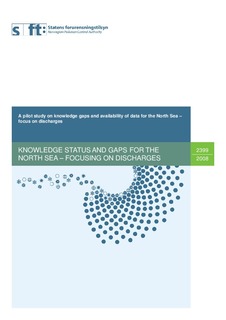| dc.contributor.author | Folkestad, Are | |
| dc.contributor.author | Nygaard, Kari | |
| dc.contributor.author | Molvær, Jarle | |
| dc.contributor.author | Oug, Eivind | |
| dc.contributor.author | Kaste, Øyvind | |
| dc.contributor.author | Kroglund, Tone | |
| dc.contributor.author | Wehde, Henning | |
| dc.contributor.author | Skaare, Bent Barmand | |
| dc.contributor.author | Jantsch, Tor Gunnar | |
| dc.contributor.author | Selvik, John Rune | |
| dc.contributor.author | Jørgensen, Nina Marit | |
| dc.contributor.author | Larsen, Lars Henrik | |
| dc.date.accessioned | 2014-09-18T08:36:42Z | |
| dc.date.available | 2014-09-18T08:36:42Z | |
| dc.date.issued | 2008 | |
| dc.identifier.isbn | 978-82-577-5315-3 | |
| dc.identifier.issn | 0803-625X | |
| dc.identifier.uri | http://hdl.handle.net/11250/220359 | |
| dc.description.abstract | The Norwegian government will develop a management plan for the Norwegian sector of the North Sea. Mapping of the data requirement related to the interaction between land, coast and ocean and identification of specially vulnerable and valuable areas are included. The project focuses on discharges and their impact on the environment in the Norwegian part of the North Sea (part of OSPAR’s Region II, Greater North Sea), however information from other countries and regions within the North Sea is also included.
OSPAR is developing a Quality Status Report for the North Sea area entitled the QSR 2010. QSR 2010 is based on regional assessments while this report is a pilot project aiming to identify additional data required for an upcoming management plan for the North Sea. OSPAR QSR 2010 will develop an assessment for the North Sea, however this will probably not be area specific enough to fulfil the needs for a management plan. In addition to the QSR 2010 there will be a need to develop regional plans based on collaboration between the NS countries. EUs directives, conventions and agencies supply a network of laws, directives and agreements relevant for a future management plan for the North Sea.
Relevant sources of data and overall estimates of the amounts of nutrients and pollutants discharged from Norwegian sources into the North Sea are presented. An assessment of the knowledge status is given for individual sectors, with a particular focus on areas where present knowledge or data availability is considered insufficient. Effects of discharges on vulnerable and valuable areas are discussed in the context available data from monitoring and future needs to fill the gaps. | nb_NO |
| dc.language.iso | eng | nb_NO |
| dc.publisher | Norsk institutt for vannforskning | nb_NO |
| dc.relation.ispartofseries | NIVA-rapport;5580 | |
| dc.relation.ispartofseries | Overvåkningsrapport;TA-2399/2008 | |
| dc.rights | Navngivelse-Ikkekommersiell-DelPåSammeVilkår 3.0 Norge | * |
| dc.rights.uri | http://creativecommons.org/licenses/by-nc-sa/3.0/no/ | * |
| dc.subject | Nordsjøen | nb_NO |
| dc.subject | Kunnskapsstatus | nb_NO |
| dc.subject | Kunnskapsbehov | nb_NO |
| dc.subject | Forvaltningsplaner | nb_NO |
| dc.subject | North Sea | nb_NO |
| dc.subject | Knowledge status | nb_NO |
| dc.subject | Knowledge gaps | nb_NO |
| dc.subject | Management plans | nb_NO |
| dc.title | Knowledge status and gaps for the North Sea – focusing on discharges. | nb_NO |
| dc.title.alternative | Kunnskapsstatus og kunnskapsbehov – hovedfokus på tilførsler | nb_NO |
| dc.type | Research report | nb_NO |
| dc.subject.nsi | VDP::Mathematics and natural science: 400 | nb_NO |
| dc.source.pagenumber | 108 | nb_NO |

